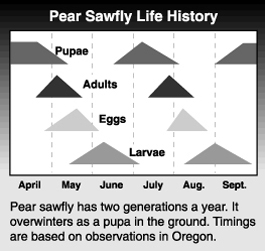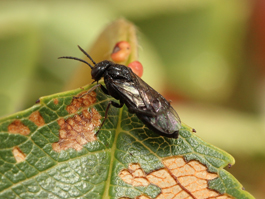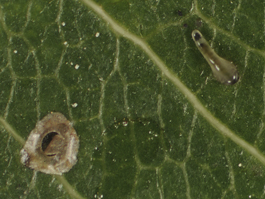by Lynn Long, originally published 1993
Caliroa cerasi (Linnaeus) (Hymenoptera: Tenthredinidae)

Pear sawfly originated in Europe and has probably been in the United States since colonial times. It is now widely distributed in the United States wherever susceptible crops are grown. It is known as pear slug because of the larva’s slimy, slug-shaped body. Although damage from the insect can be severe, especially on pear and sweet cherry, it is not considered a major pest. A standard spray program for other orchard pests usually keeps pear sawfly populations below damaging levels. However, frequent, limited outbreaks have been reported in sweet cherry orchards in the Mid-Columbia region of Oregon and Washington.
Hosts
Pear sawfly prefers pears and cherries but will also damage leaves of plum, quince, and occasionally apple. Eggs are often laid on peach leaves in trees near infested pear and cherry orchards, but larvae do not thrive on peach.
Life stages
Egg
The egg is about 1 mm long, oval, tan, and looks like a small blister on the leaf. Eggs are laid on the upper leaf surface.
Larva
The larva passes through five instars. The young larva is about 1.4 mm long, and resembles a small slug due to the olive green slime that covers its body. The front end of the insect is wider than the rest of the body. The back end is slightly tapered and raised a little from the leaf surface on which it feeds. Newly molted larvae are yellow until the slime is secreted. During the last instar, the larva loses its slimy covering and is a light orange-yellow color. At this stage, it is about 3/8 inch (10 mm) long and has 10 pairs of legs.
Adult
The adult is a glossy black wasp, about 1/5 inch (5 mm) long.
Life history
 Pear sawfly overwinters as a pupa in a cocoon 2 to 3 inches deep in the soil. In the Northwest, first-generation adults emerge over an extended period in late spring.
Pear sawfly overwinters as a pupa in a cocoon 2 to 3 inches deep in the soil. In the Northwest, first-generation adults emerge over an extended period in late spring.
The adult female inserts eggs into the leaf tissue with her saw-like ovipositor. Incubation lasts 10 to 15 days. Larvae are present in late spring or early summer and immediately begin to feed on the upper surface of the leaf. It takes 3 to 4 weeks for the larvae to pass through the five stages of development. Fifth instar larvae do not feed but crawl or drop to the ground and pupate.
Second generation adults begin to emerge in July. They emerge over a shorter period of time than the first generation. Adults lay eggs soon after mating, and larvae appear in August and September. It is this generation of larvae that is the most destructive. Mature larvae drop to the ground for the overwintering pupal stage.
Damage

Pear sawfly feeds on the upper surface of leaves, skeletonizing them. On heavily infested trees, leaves turn brown, wither and drop. Defoliation on either pear or cherry can weaken the tree. Infestations can also stunt fruit and prevent maturation.
Monitoring
It is important to monitor continually for the slug-like larvae in August and September when large populations can build up rapidly and cause significant damage. Pay special attention to cherries, which are often neglected after harvest. A few acres within a block can easily become infested unless the trees are monitored regularly.
Biological control
Little is known about biological control of the pear sawfly. Since the insect is usually not a problem in unsprayed backyard trees, natural enemies may be controlling it.
Management
Because pear sawfly larvae are susceptible to most insecticides, they are easily controlled in commercial orchards. Generally, normal spray programs for other pests will keep this insect in check. If a problem develops, it is usually after harvest on cherries when insecticides are no longer being used. In these cases, trees can be defoliated in August or September. This seems to have little effect on the following year’s crop on mature trees, but the consequences may be more serious on young bearing trees. If control is necessary, an organophosphate insecticide would be effective.
Pear Slug Gallery
Materials available for pear
Excerpt from the WSU Crop Protection Guide. For timings at which each pesticide can be used refer to the Crop Protection Guide.
Materials available for sweet cherry
Excerpt from the WSU Crop Protection Guide. For timings at which each pesticide can be used refer to the Crop Protection Guide.




